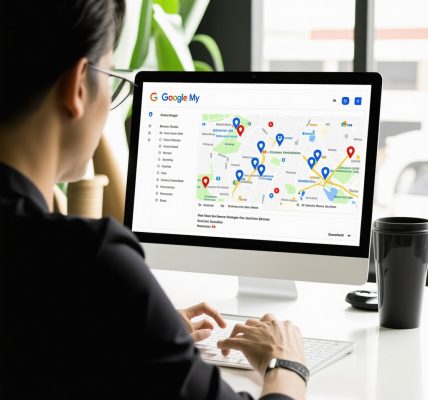Unlocking the Power of Strategic Keywords in Your GMB Business Description
In the competitive landscape of local search, a well-crafted Google My Business (GMB) description can be the linchpin that differentiates your business from countless others. Integrating targeted keywords into your GMB description is not just about stuffing phrases; it’s a subtle art of weaving relevant search terms naturally to enhance visibility and attract local customers. This nuanced approach demands more than just inserting popular keywords; it requires an understanding of user intent, local search trends, and how Google’s algorithm interprets business profiles.
Weaving Local Relevance into Your Narrative: The Semantics of Local SEO
Successful GMB descriptions resonate with the local audience by incorporating Latent Semantic Indexing (LSI) keywords—terms closely related to your main keywords that Google associates with your business category. For instance, a bakery in Seattle might include phrases like “artisan bread,” “Seattle pastries,” or “freshly baked goods near Pike Place Market.” This semantic richness not only bolsters your profile’s relevance but also aligns with how search engines contextualize your offerings, thereby enhancing your local search rankings.
How Can You Ensure Your GMB Description Balances Keywords and Authentic Brand Voice?
One of the most challenging aspects of crafting GMB descriptions is maintaining authenticity while optimizing for SEO. Your description should reflect your brand’s unique value and expertise, avoiding generic or robotic language. A compelling narrative might describe your business’s passion, history, or commitment to quality, naturally embedding targeted keywords where they fit seamlessly. For example, instead of saying “We sell coffee,” consider “At Seattle’s premier coffee roasters, we craft small-batch, ethically sourced coffee that delights local connoisseurs.” This approach builds trust, engages readers, and satisfies SEO criteria simultaneously.
Experience-Driven Insights: Case Study on Keyword Optimization Impact
Consider a local landscaping company that revised its GMB description by incorporating geo-specific keywords and related service terms such as “garden design in Austin,” “sustainable landscaping,” and “residential lawn care.” Within weeks, their profile saw a marked increase in impressions and customer inquiries. This practical example underscores the importance of targeted keyword research combined with an engaging description that appeals to both users and search engines alike.
Expert Tips for Maximizing Your GMB Description’s SEO Impact
- Conduct thorough keyword research using tools like Google Keyword Planner tailored for local queries—focus on intent-driven phrases that potential customers actually search for.
- Limit your description to 750 characters, prioritizing clarity and relevance without overloading keywords.
- Incorporate a call-to-action subtly within your description to encourage user engagement.
- Update your description periodically to reflect new services, promotions, or seasonal offerings, keeping your profile dynamic and relevant.
For further detailed strategies on keyword integration and GMB optimization, explore our comprehensive guide on how to use GMB business description keywords effectively.
Understanding and applying these principles can transform your Google Business Profile into a powerful local SEO asset. Share your experiences or questions below to join the conversation and elevate your local visibility!
Additionally, authoritative insights from Moz’s Local SEO guide offer valuable foundational knowledge that complements the targeted keyword strategies discussed here.
Leveraging User-Generated Content to Amplify Your GMB Keyword Strategy
User-generated content, particularly customer reviews, has become a pivotal element in enhancing your Google My Business profile’s SEO performance. When customers naturally incorporate relevant keywords and local phrases in their reviews, it broadens the semantic reach of your listing, reinforcing your local relevance. Encouraging satisfied clients to mention specific services, locations, or unique features can subtly enrich your GMB description’s keyword landscape without artificially manipulating content. This organic approach aligns with Google’s E-E-A-T (Experience, Expertise, Authoritativeness, Trustworthiness) framework, ensuring your profile gains authority through authentic engagement.
Integrating Structured Data: Can Schema Markup Elevate Your GMB Description?
While Google My Business listings primarily rely on the information you provide directly, implementing structured data markup on your website can indirectly boost your GMB profile’s visibility. Schema markup helps search engines better understand your business details, which can reflect positively on your local search presence. For example, marking up your business address, services, and operating hours on your site with LocalBusiness schema can create a cohesive and authoritative digital footprint. This synergy between your website and GMB listing signals reliability and relevance, potentially improving your local rankings.
What Are the Best Practices for Maintaining Keyword Relevance Without Over-Optimization in GMB Descriptions?
Balancing keyword optimization with natural language is crucial to avoid penalties from search engines that detect keyword stuffing or unnatural phrasing. Best practices include:
- Prioritize readability: Write for your audience first, ensuring the description flows smoothly and clearly conveys your value proposition.
- Use synonyms and related terms: This expands keyword coverage without repetitive usage.
- Regularly audit your description to remove outdated keywords and incorporate emerging local trends or seasonal terms.
- Stay within character limits: Google restricts GMB descriptions to 750 characters, so every word must be purposeful.
Mastering this balance protects your profile’s credibility and enhances user trust, which is equally important as search engine optimization.
Cross-Channel Consistency: Aligning Your GMB Description with Other Local SEO Signals
Consistency across your digital marketing channels—such as your website, social media profiles, and citation listings—is fundamental for reinforcing your local SEO signals. Your GMB description should reflect the core keywords and messaging used elsewhere to build a unified brand narrative. Discrepancies in business name, address, phone number (NAP), or service descriptions can confuse search engines and harm rankings. Ensuring that your GMB keywords complement your broader local SEO strategy strengthens your business’s digital footprint and improves discoverability.
For further exploration of citation management and its impact on local rankings, consider our detailed article on best practices for GMB citation management.
According to recent insights from Moz’s 2024 Local SEO Ranking Factors, the integration of keyword-rich, customer-focused content in GMB descriptions remains a significant driver of local search success, emphasizing the importance of authentic, well-researched keyword usage.
Have you experimented with different keyword approaches in your GMB description? Share your strategies and results in the comments below to help fellow local businesses thrive!
Harnessing Behavioral Data to Refine GMB Keyword Targeting
Beyond traditional keyword research, leveraging behavioral analytics can significantly elevate the precision of your Google My Business description optimization. Understanding how users interact with your business listing—such as click-through rates, direction requests, and call actions—provides implicit feedback on which keywords and phrases resonate most effectively with your target audience. Integrating these insights enables you to iteratively refine your keyword selection to mirror real-world user intent, thereby enhancing engagement and conversion rates.
For example, if analytics indicate higher engagement from searches including “eco-friendly landscaping Austin,” incorporating this phrase organically into your GMB description can capitalize on proven user interest. This data-driven approach aligns with advanced SEO methodologies that prioritize user behavior signals as ranking factors, as noted in Search Engine Journal’s 2024 Local SEO Ranking Factors.
Semantic Keyword Clustering: Crafting Contextually Rich Descriptions
Moving beyond isolated keywords, semantic keyword clustering groups related terms into thematic categories, enriching your GMB description with contextual depth. This technique enhances your profile’s topical authority by demonstrating a comprehensive understanding of the business domain and its associated services.
For instance, a dental clinic might cluster keywords such as “cosmetic dentistry,” “teeth whitening,” “dental implants,” and “oral hygiene education” into a cohesive narrative that reflects both general and specialized services. This thematic consistency not only appeals to Google’s natural language processing algorithms but also provides potential customers with a clear, expert overview of what sets your business apart.
Can Integrating Latent Semantic Indexing (LSI) Keywords in GMB Descriptions Improve Local Rankings?
Indeed, incorporating LSI keywords—terms semantically related to your primary keywords—into your GMB description helps search engines better comprehend the breadth and relevance of your offerings. LSI keywords support natural language patterns, reducing the risk of keyword stuffing while expanding your profile’s reach in related search queries. For example, a “Seattle bakery” might include LSI terms such as “artisan bread,” “pastry shop,” and “local baked goods.” This approach enriches content quality and aligns with Google’s emphasis on user experience and semantic understanding, as outlined in Google’s official Structured Data guidelines.
Advanced CTA Integration: Subtle Yet Strategic Engagement Drivers
Embedding calls-to-action (CTAs) within your GMB description enhances user interaction without compromising keyword integrity. Strategic CTAs should be concise, contextually relevant, and aligned with the user’s search intent. Examples include “Schedule your free consultation today,” or “Visit our downtown storefront for exclusive offers.” These prompts not only encourage direct engagement but also signal to search engines active user involvement, potentially boosting your listing’s prominence.
Moreover, combining CTAs with localized keywords can create compelling, action-oriented phrases that enhance both SEO and conversion potential. For instance, “Call our Austin office for sustainable landscaping solutions” seamlessly merges location-specific keywords with a strong CTA.
Ready to elevate your Google My Business profile with these expert strategies? Dive deeper into advanced keyword optimization techniques and join our community of local SEO professionals for ongoing insights and support.
Harnessing Behavioral Analytics to Tailor GMB Keyword Targeting
In the realm of local SEO, traditional keyword research only scratches the surface. Leveraging behavioral analytics equips you with actionable intelligence to finetune your Google My Business description based on actual user interactions. Metrics such as click-through rates, direction requests, and phone call engagements reveal which keywords resonate profoundly with your audience. By integrating these insights, you can dynamically optimize your description to reflect evolving user intent and preferences, thus maximizing both visibility and conversion potential.
For instance, if data shows increased queries involving “eco-friendly landscaping Austin,” embedding this phrase organically within your GMB profile capitalizes on proven demand, aligning your content with user behavior patterns noted by advanced SEO practitioners.
Semantic Keyword Clusters: Building Contextual Authority in Your GMB Narrative
Moving beyond isolated keywords, semantic clustering groups related search terms into cohesive themes, enriching your GMB description with contextual depth and topical relevance. This strategy showcases a comprehensive understanding of your business niche and enhances Google’s comprehension through natural language processing.
Take a dental clinic as an example: clustering terms like “cosmetic dentistry,” “teeth whitening,” “dental implants,” and “oral hygiene education” weaves a nuanced narrative that appeals to both search engines and prospective patients, establishing your profile as an authoritative local resource.
How Does Incorporating Latent Semantic Indexing (LSI) Keywords in GMB Descriptions Impact Local SEO Performance?
Incorporating LSI keywords—semantically related phrases that complement your core keywords—can significantly boost your local search rankings. These keywords help Google better contextualize your offerings, reducing risks of keyword stuffing while broadening your reach to relevant queries. For example, a “Seattle bakery” might integrate LSI terms such as “artisan bread,” “pastry shop,” and “local baked goods,” enriching the content’s semantic fabric and enhancing user experience.
Google’s official Structured Data guidelines underscore the importance of semantic clarity, making LSI integration a best practice for local SEO specialists aiming for sustainable ranking improvements.
Advanced CTA Integration: Crafting Subtle Engagement Triggers within Your GMB Description
Embedding thoughtfully designed calls-to-action (CTAs) in your GMB description can elevate user engagement without compromising keyword strategy. Effective CTAs are concise, contextually relevant, and aligned with search intent. Phrases such as “Schedule your free consultation today” or “Visit our downtown storefront for exclusive offers” encourage direct user interaction, signaling active engagement to search algorithms and enhancing your profile’s prominence.
Moreover, fusing CTAs with location-specific keywords, like “Call our Austin office for sustainable landscaping solutions,” creates compelling prompts that simultaneously boost SEO value and conversion potential.
Ready to transform your Google My Business profile with these advanced insights? Dive deeper into semantic optimization and behavioral analytics to unlock unparalleled local search success. Join our expert community for ongoing strategies and support.
Frequently Asked Questions (FAQ)
What is the ideal length for a Google My Business (GMB) description to maximize SEO impact?
The recommended length for a GMB description is up to 750 characters. This limit encourages concise, clear messaging that naturally incorporates relevant keywords without keyword stuffing. Staying within this boundary ensures your description is fully displayed and effectively communicates your brand’s value while optimizing for local search.
How can I incorporate keywords into my GMB description without making it sound robotic or spammy?
Focus on writing a natural, engaging narrative that reflects your brand voice. Use synonyms, related terms, and LSI (Latent Semantic Indexing) keywords to diversify language. Embed keywords contextually within sentences that highlight your unique offerings, history, or customer benefits. This approach maintains authenticity and optimizes SEO simultaneously.
Why is local relevance important when selecting keywords for my GMB description?
Local relevance helps your business appear in geographically targeted search results. Incorporating geo-specific keywords and semantic terms related to your community signals to Google that your business serves local customers, improving your visibility for nearby searches and increasing the likelihood of attracting qualified leads.
Can customer reviews influence the keyword effectiveness of my GMB profile?
Yes. When customers naturally mention services, locations, or features in their reviews, they add valuable user-generated content rich in relevant keywords. This broadens your profile’s semantic footprint, reinforcing your local relevance and authority in Google’s eyes, which can positively affect rankings.
How does structured data markup on my website complement my GMB description?
Structured data (such as LocalBusiness schema) on your website helps search engines understand your business details more precisely. This enhanced understanding supports your GMB profile by creating a consistent and authoritative digital presence, thereby boosting your business’s overall local SEO performance.
What are semantic keyword clusters, and how do they improve my GMB description?
Semantic keyword clusters group related keywords into thematic categories that reflect different aspects of your services or products. Including these clusters in your description enriches its contextual depth, helping search engines better interpret your business’s scope and increasing your profile’s topical authority.
How can behavioral data refine my keyword targeting for GMB descriptions?
Behavioral analytics reveal which keywords drive actual user engagement with your listing—such as clicks, calls, and direction requests. By analyzing this data, you can optimize your description to emphasize phrases proven to resonate with your audience, improving relevance and conversion potential.
Is it beneficial to include calls-to-action (CTAs) within my GMB description?
Yes. Strategically placed CTAs encourage user interaction and signal active engagement to search engines, potentially improving your ranking. Effective CTAs are concise, relevant, and can incorporate location-specific keywords to boost both SEO value and user conversions.
How often should I update my GMB description to maintain SEO effectiveness?
Regular updates are advisable to reflect new services, promotions, or seasonal trends. Periodic revisions keep your profile fresh and relevant, align with evolving user intent, and allow you to incorporate emerging local keywords or behavioral insights for sustained SEO performance.
What risks should I avoid when optimizing my GMB description with keywords?
Avoid keyword stuffing, unnatural phrasing, and discrepancies in business information across platforms. Over-optimization can lead to penalties or diminished user trust. Prioritize readability, accuracy, and consistency to maintain credibility and comply with Google’s guidelines.
Trusted External Sources
- Moz Local SEO Guide: This authoritative resource provides foundational and advanced insights into local search optimization techniques, including practical keyword integration strategies for Google My Business profiles.
- Google Developers – Structured Data Guidelines: Offers official documentation on implementing schema markup, crucial for enhancing search engines’ understanding of local business information and complementing GMB optimization efforts.
- Search Engine Journal – Local SEO Ranking Factors 2024: An industry-leading publication presenting data-driven analysis on the latest local SEO trends, behavioral signals, and ranking factors that inform effective GMB keyword strategies.
- Google My Business Help Center: Provides up-to-date best practices and policies directly from Google, helping businesses comply with platform rules and optimize their profiles effectively.
- BrightLocal Local Consumer Review Survey: Offers empirical data on the impact of user-generated content and reviews in local search behavior, reinforcing the importance of authentic customer feedback in SEO.
Conclusion
Optimizing your Google My Business description with expertly chosen, semantically rich keywords is a critical lever for enhancing local SEO performance. By blending targeted keyword research, local relevance, behavioral analytics, and user-centric narrative, your GMB profile can transcend mere presence to become a compelling, authoritative beacon for local customers. Integrating advanced strategies such as semantic keyword clustering and subtle CTAs further refines your profile’s engagement and visibility. Maintaining consistency across all digital channels and leveraging structured data amplifies your local search footprint, ensuring your business stands out in an increasingly crowded marketplace.
Empowered with these insights, you can craft a GMB description that not only satisfies Google’s algorithms but also resonates authentically with your audience, driving meaningful customer interactions and sustained growth. We invite you to share your experiences, ask questions, and explore related expert content to continue mastering local SEO excellence.




I found the discussion about balancing keyword optimization and maintaining an authentic brand voice especially insightful. In my experience managing a small café’s GMB profile, simply inserting keywords felt forced and didn’t connect well with our community. Instead, we focused on telling our story—highlighting our commitment to locally sourced ingredients and cozy atmosphere—while naturally incorporating related keywords like “farm-to-table brunch” and “downtown organic café.” This approach not only improved our local search visibility but also helped us attract customers who appreciate authenticity. Also, regularly updating the description seasonally (like promoting our autumn pumpkin specials) keeps our profile fresh and relevant. I’m curious how others navigate the challenge of weaving in LSI keywords without diluting their unique brand narrative? Have you found any creative techniques or tools particularly helpful for this delicate balance?
Emily, your approach to weaving your café’s story into the GMB description while naturally including related keywords like “farm-to-table brunch” really resonates. From my experience managing local retail profiles, one technique that helps balance LSI keywords without diluting brand voice is creating a thematic keyword list aligned with core messaging before writing. This way, you ensure that synonyms and related terms fit organically within the narrative rather than feel like afterthoughts. Tools like Clearscope or Surfer SEO provide semantic keyword suggestions that can guide this process effectively. I also find it useful to incorporate customer language from reviews, which naturally include relevant phrases and local terms, thus enhancing authenticity. Seasonal updates, as you mentioned, are key for keeping descriptions dynamic, and they also present opportunities to rotate in timely LSI keywords subtly. Has anyone else experimented with integrating behavioral analytics data to inform which LSI terms to prioritize in their GMB descriptions? It seems a data-driven layer might be the next step to perfecting that rare mix of keyword strategy and genuine storytelling.
This article offers some fantastic insights into the delicate balance of keyword integration and maintaining brand authenticity in GMB descriptions. From my experience managing local service businesses, I’ve noticed that storytelling combined with strategic keyword placement really resonates with both Google and potential customers. One approach I’ve found effective is starting with a great narrative that highlights your unique value proposition and then naturally weaving in keywords that align with customer search intent. I’m also curious—how do others handle updates during seasonal changes without overloading their descriptions with keywords? Have any tools or techniques helped streamline this process? I believe that staying relevant and authentic is key to building trust and improving local rankings over time.